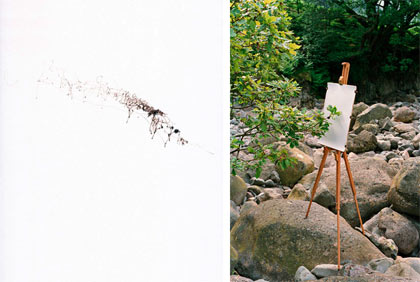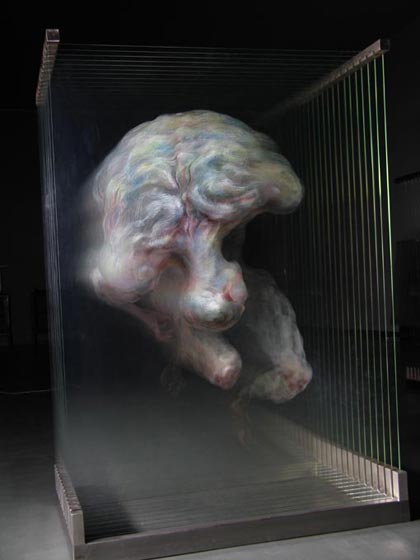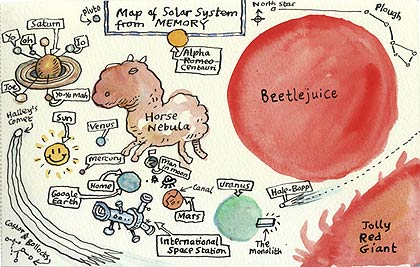kottke.org posts about Art
Artist Eve Mosher is drawing a chalk line around Brooklyn and lower Manhattan that denotes the encroachment of the ocean if it were to rise 10 feet above the current sea level. There’s a web site for the project, including a progress blog. See also Flood Maps.
Regarding my post about Tim Knowles’ work, Greg sent in a couple of links to similar projects. Olafur Eliasson created these drawings much like Knowles did with his Vehicle Motion Drawings, except he used the motion of his father’s fishing boat. William Anastasi has done drawings for almost 40 years by letting his pen drift on a piece of paper while riding the subway.
I just stumbled upon the work of Tim Knowles, whose art explores the mostly hidden, obscured, or otherwise unnoticed motion of objects. One of his projects is Tree Drawings:
Drawings produced by pens attached to the tips of tree branches, as the branches move in the wind the tree draws on to a panel or drawing board on an easel. Like signatures the trees drawings tell of the tree’s character; a Hawthorn producing a stiff, scratchy & spikey drawing an Oak a more elegant flowing line.
Here’s the oak at its easel and the resulting art:

For Vehicle Motion Drawings, he constructed an apparatus to capture the motion of a car being driven…the turns, stops, and starts of the vehicle move the pen over the paper. His postal projects capture the motion of packages through the postal system, both with drawings and photography. (Knowles’ Spy Box reminds me of Kyle Van Horn’s cameramail.)
Love his stuff. (via waxy)
Opening Friday, June 22 at jen bekman gallery in NYC: A New American Portrait, “a group exhibition of photographs featuring artists at the vanguard of contemporary portraiture in America”. Curated by Jen Bekman and Joerg Colberg, one of my favorite bloggers on the topic of photography.
Decisions, Decisions: a nice looking hand-drawn flowchart poster.
Nina Katchadourian’s Sorted Books project, photographs of book spines arranged to tell short stories.
Hair portraits, including those of Star Wars and Guns n Roses.
My wife Meg makes A Mean Chocolate Chip Cookie. That is to say, she asked her readers for their best chocolate chip cookie recipes, averaged the ingredient amounts, baking times, chilling times, butter consistencies, and other various techniques and baked according to the resulting recipe (which she includes so you can bake up your own batch). Some of the ingredients: “2.04 cups all-purpose flour; 0.79 tsp. salt; 0.79 tsp. baking soda; 0.805 stick unsalted butter, softened to room temperature; 0.2737 stick unsalted butter, cold; 0.5313 stick unsalted butter, melted.” Reminds me a bit of The Most Wanted Paintings project by Komar & Melamid, who averaged aesthetic preferences and taste in painting to produce works of art that appealed to everyone (to hilarious effect). (digg this?)
Interview with artist Kristan Horton, whose project Dr. Strangelove Dr. Strangelove recreates scenes from the movie using everyday household objects.
Why are most artists liberal? “In conclusion, then, you don’t have to be a liberal to be a good storyteller. But the better your story is, the more of a liberal you are.” (via 3qd)
Street artist Banksy gets the New Yorker treatment with a profile in this week’s issue. “The graffitist’s impulse is akin to a blogger’s: write some stuff, quickly, which people may or may not read. Both mediums demand wit and nimbleness. They arouse many of the same fears about the lowering of the public discourse and the taking of undeserved liberties.” Complex tracked down the alleged photos of Banksy mentioned in the article. Print magazine recently wrote a piece on Banksy as well.
Analysis of a recent New Yorker cover, the one with the guy and girl standing in front of an abstract expressionist painting. “Rather than a couple in love with each other, with art, and with technological possibility, I see a boy with a toy, and a girl with patience. He is much more engaged with the devise; she curves demurely away.” The phrase “boy with a toy, and a girl with patience” describes many American relationships, I think. (thx, david)
Update: The NYer cover is a reference to this Jan 1962 Saturday Evening Post cover by Norman Rockwell. (thx, maciej)
Clever technique for pinching the colors from famous paintings using the Match Color tool in Photoshop. “The Old Masters of painting spent years of their lives learning about color. Why let all their effort go to waste on the walls of some museum when it could be used to give you a hand with color correction?”
Typographic map of London. That is, a map made of type (like Paula Scher’s paintings) not a map of typography in London. (via moon river)
What kind of art is film? High art? Mass art? Photographic art? Narrative art?
Artist Xia Xiaowan uses layers of glass to make 3-D paintings. A picture’s worth a thousand words of explanation in this case:

Xia Xiaowan surpasses the boundaries of painting and establishes a new way of “looking” at paintings. He draws his inspiration and method from X-ray photographs, giving two-dimensional painting a three-dimensional effect. He combines material, technology and painting, thus maintaining the hand-made qualities of painting while adding elements of installation and sculptural art and displaying the cold, absurd and strange qualities of realism.
More work by Xia Xiaowan here.
Update: Marilène Oliver does similar work. (thx, emmett)
Joerg Colberg asked a bunch of photographers and photography bloggers: what makes a great photo? The answers, with examples, form a great informal discussion about art, photography, and curating. “It’s hard for me to describe what makes a great photo mostly because it’s hard to predict what you might like before you see it. I’m often surprised by things that I’ve never thought I would enjoy or seek out in the world.”
Related to the men look at crotches post, here’s an eyetracking study that compares how artists look at a photo with the rest of us. “Non-artists spent significantly more time looking at [human bodies and faces in the photos] than artists.” (via snarkmarket)
For the past five years, artist Jackie Sumell has been helping Herman Wallace, who has been in solitary confinement at the Louisiana State Penitentiary for the last 34 years, design his dream house, a house that will probably never be built. “Traces of a prison mindset crop up. When the placement of his computer meant his back would face the office door, Ms. Sumell said that he asked that a mirror be installed above, so he could see anyone entering the room. A sense of security is important to him, she explained. The master bedroom sits safely above the very center of the house. A wraparound porch adds a layer of perimeter, as does the surrounding garden. There is even a special door leading to an underground bunker, equipped with its own water supply.” A book on the project is available for a $20 donation and this PDF gives a good overview of the project.
The first time I saw a world map drawn from memory was at Christopher Fahey’s apartment. I forget how long it took him to draw, but it was remarkably accurate and fairly large (a few feet across). Ever since then, I’ve kept an eye out for other hand-drawn maps (you know what they say: if you can’t do, collect). Via waxy this morning comes the From Memory Flickr group. My favorites from the group are this map of the male human body and a fanciful drawing of the solar system, both by Ellis Nadler:

Mapping.com has links to several maps from memory drawn by grade- and middle-school children; this world map by a 7th grade class is not too shabby. I’m struck by how much some of these world maps from memory resemble world maps drawn in the 16th and 17th centuries, like this Dutch map from 1689. All the parts are (mostly) there…it’s just that everything is a little wrong-sized and slightly skewed.
Lori Napoleon collects “personal maps” from various people. This tactical guide for nourishing yukio includes directions to the owner’s house, outlines of the two different keys (outside door, inside door), and what to feed the cat and when.
Also slightly related is the Fool’s World Map, a deliberately addled world map prompted by a question asked of the map-maker by a Texan: “How many hours does it take to go to Japan by car?”
Update: Despite having featured his work on kottke.org late last year, I completely forgot about Stephen Wiltshire’s super-realistic drawings from memory. Here’s video of Stephen drawing Tokyo from memory and Rome from memory. (thx, matt)
Update: Christopher Fahey uploaded a photo of his world map drawn from memory.
Quantitatively, the greatest women artists in the 20th century were, in order, Cindy Sherman, Georgia O’Keeffe, Louise Bourgeois, Eva Hesse, and Frida Kahlo. (via mr)
Newer posts
Older posts








Stay Connected